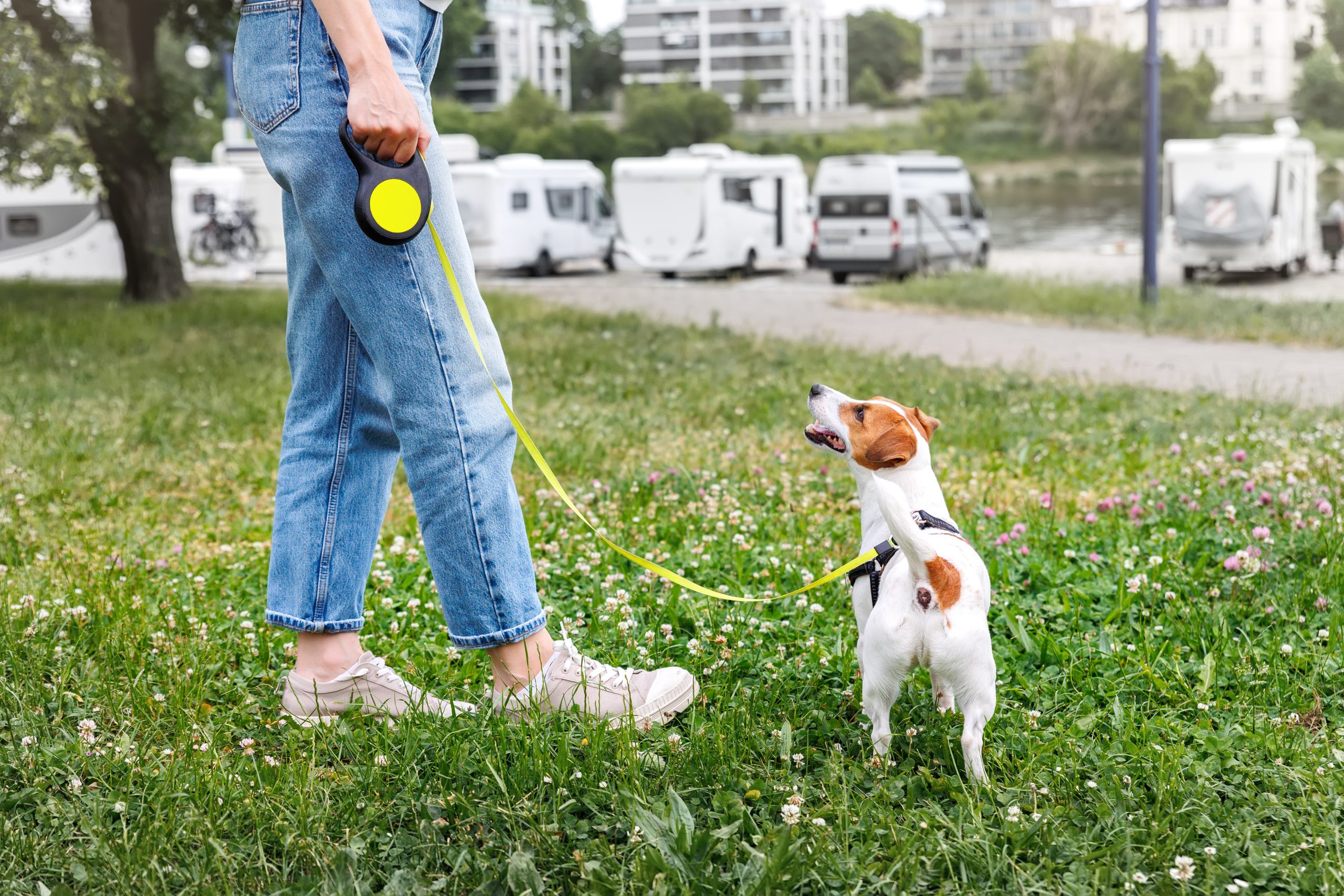The freedom of the open road becomes even more special when shared with our four-legged family members. At Happy Camper Insurance, we understand that RV adventures are better with pets, but they also require thoughtful preparation and consideration. Here’s your comprehensive guide to making your RV travels safe and enjoyable for everyone in your crew, whether they walk on two legs or four.
Safety First: Securing Pets in Your RV
The most important aspect of RVing with pets is ensuring their safety during both travel and camping. Unlike traditional homes, RVs present unique challenges and opportunities for pet safety that require special attention to detail.
While Driving
Just as you wouldn’t travel without securing your belongings, your pets need proper restraints during transit. Install sturdy pet barriers between the driving area and living space to prevent distractions while on the road. For optimal safety, use secured crates or pet carriers that are properly anchored to the RV’s structure. If your pets ride in the cab area, invest in special pet seat belts designed for RV use. Never allow pets to roam freely while the RV is in motion, as sudden stops could lead to injury.
During Camping
Once you’ve reached your destination, your RV becomes a temporary home that needs to be as secure as your permanent residence. Install pet screens on windows and doors to prevent escape while allowing fresh air circulation. Consider using tie-outs that attach to your RV’s frame or dedicated pet stakes for supervised outdoor time. Many experienced RV pet owners find that a portable pet fence provides the perfect balance of freedom and security at the campsite.
Creating a Pet-Friendly RV Space
Transforming your RV into a comfortable space for pets requires thoughtful modifications and considerations that go beyond basic safety measures. The key is to creating an environment that feels like home while accommodating the unique challenges of RV living.
Temperature Control
Climate management becomes particularly crucial when traveling with pets in an RV. Install a reliable remote temperature monitoring system that allows you to check conditions from your phone, even when you’re away from your RV. Proper air circulation is essential, so consider installing multiple fans throughout your RV. A backup generator dedicated to powering your AC during outages can provide peace of mind during hot weather. Remember that the temperature at human eye level may be quite different from what your pet experiences closer to the floor or in their favorite resting spots.
Comfort Features
Within the confined space of an RV, creating dedicated areas for your pets helps them feel secure and comfortable. Designate a specific “pet zone” with familiar bedding and toys from home. Install non-slip flooring or mats to prevent slipping during transit, and consider pull-out feeding stations to maximize space efficiency. Think vertically for cats, installing climbing spaces and perches that don’t intrude on human living areas.
Campground Considerations
Successful RV camping with pets requires careful planning before you ever pull into a campsite. Understanding and preparing for the unique challenges of each location will help ensure a smooth stay for everyone.
Choosing Your Destination
The perfect campground for pet owners offers more than just a “pets allowed” policy. Research facilities thoroughly to understand their specific pet policies, including breed restrictions, leash requirements, and designated pet areas. Look for campgrounds that offer amenities like dog parks or walking trails. Consider the surrounding area as well – proximity to veterinary care and pet supply stores can be crucial for longer stays.
Creating Your Campsite Setup
Upon arrival, take time to create a pet-friendly environment that will serve you throughout your stay. Set up a designated outdoor pet area that provides both shade and shelter from rain. Install outdoor lighting or use LED collar accessories for nighttime safety. A dedicated paw-washing station near your RV entrance can help maintain cleanliness, while outdoor cameras allow you to monitor your pets when they’re enjoying the fresh air.
Managing Pet Health on the Road
Maintaining your pet’s health during extended RV travel requires planning and vigilance. A healthy pet makes for a much more enjoyable journey for everyone involved.
Preventative Care
Schedule a comprehensive vet check-up before embarking on any extended RV adventure. Ensure all vaccinations are current and obtain copies of medical records to carry with you. Discuss your travel plans with your veterinarian, who may recommend additional preventative measures based on your destinations. Consider getting your pet microchipped if they aren’t already, and always keep identification tags updated with current contact information.
Emergency Preparedness
Compile a detailed pet first aid kit specifically for RV travel, including basic supplies for minor injuries and any medications your pet regularly takes. Research emergency veterinary clinics along your planned route, saving their contact information and locations in advance. Consider investing in pet insurance that covers emergency care anywhere in the country, and familiarize yourself with their claim submission process while traveling.
Insurance Considerations
Understanding your insurance coverage becomes even more critical when traveling with pets in an RV. Both your RV insurance and pet insurance policies play important roles in protecting your entire family.
RV Coverage
Standard RV insurance policies may not automatically cover pet-related incidents or damage. Review your policy carefully to understand coverage for pet-caused damage to your RV’s interior, liability coverage for pet-related incidents at campgrounds, and coverage for pet injuries in case of an accident. Many RV owners find that additional pet-specific coverage provides valuable peace of mind.
Pet Insurance
Traditional pet insurance takes on new importance during RV travel. Verify that your policy provides coverage throughout your planned travel area and understand how to handle emergency vet visits while on the road. Some policies offer additional travel-related benefits, such as emergency boarding coverage if you face an unexpected hospitalization during your trip.
Making the Most of RV Life with Pets
The joy of RV travel with pets comes from finding the right balance between adventure and routine, excitement and security. Success lies in maintaining familiar patterns while embracing new experiences together.
Maintaining Routines
Pets thrive on consistency, even during travel. Try to maintain regular feeding and exercise schedules as much as possible. Create familiar sleeping arrangements within your RV that mirror their home setup. Continue any training routines or commands they know from home – this consistency helps them feel secure in new environments.
Creating New Adventures
While routine provides security, RV life offers countless opportunities for enriching experiences with your pets. Research pet-friendly attractions along your route, from hiking trails to pet-welcome restaurants with outdoor seating. Document your adventures together through photos and perhaps even a travel blog – many RV pet owners find joy in sharing their experiences with the broader RV community.
Tips for Taking Your Dog on a Road Trip: The Final Word
RV travel with pets can be one of life’s greatest adventures when properly planned and executed. The key to success lies in thorough preparation, flexibility, and understanding your pet’s unique needs. Start with short trips to help your pet adjust to RV life, and always maintain a backup plan for unexpected situations.
Remember that every pet is different – what works for one may not work for another, so be patient as you discover what makes your furry friend most comfortable on the road.
By following these guidelines and maintaining proper insurance coverage, you can create amazing memories with your pets while exploring the country in your RV. Contact Happy Camper Insurance today to ensure your coverage includes everything you need for traveling with your four-legged family members.


